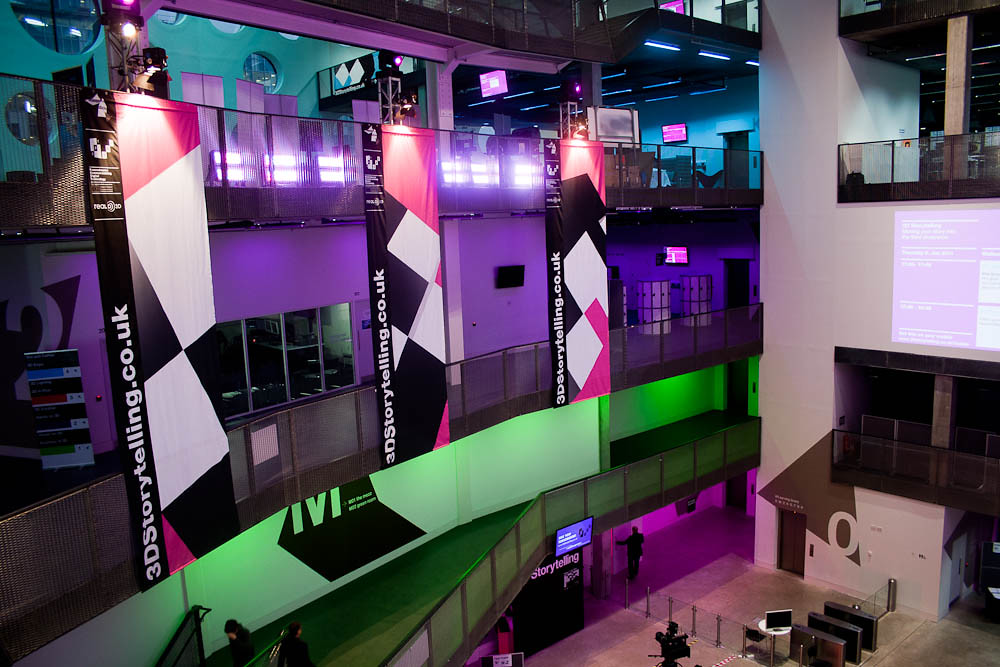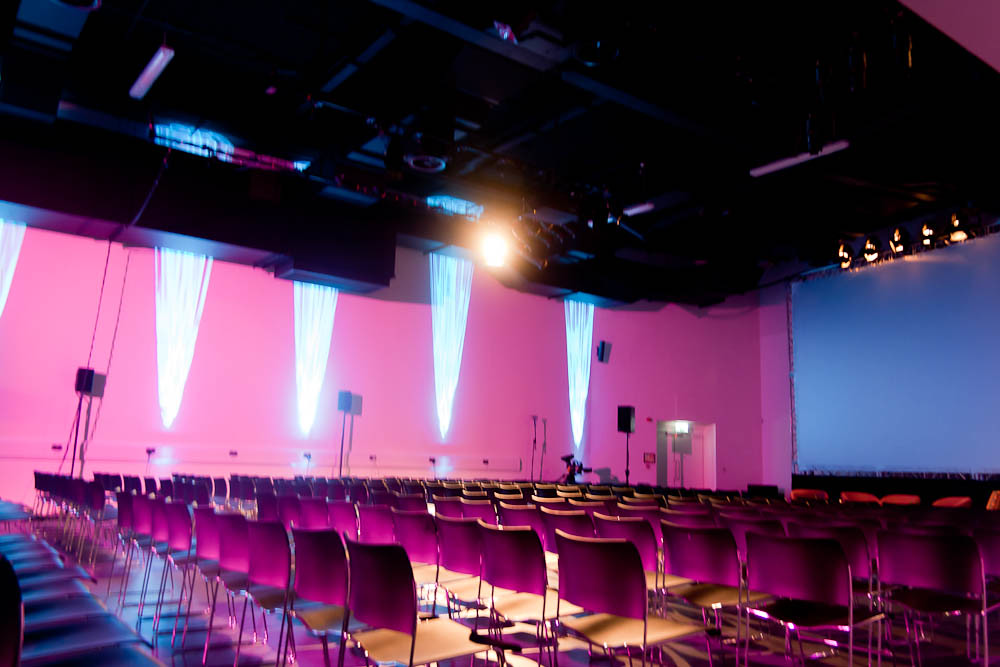Uncategorized
PROJECT: 3D Storytelling Conference
0 Over the last week I have had the opportunity to work on the world’s first 3D Storytelling Conference at Ravensbourne. The first couple of day’s I was just assisting with the rigging and gel’ing of over 300 lights through out the building. The design reason behind having to gel so many lights was to colour code each floor with the Conferences colour scheme, and I’m glad to say the end result was worth it, and the building looked amazing as you can see from the picture on the right.
Over the last week I have had the opportunity to work on the world’s first 3D Storytelling Conference at Ravensbourne. The first couple of day’s I was just assisting with the rigging and gel’ing of over 300 lights through out the building. The design reason behind having to gel so many lights was to colour code each floor with the Conferences colour scheme, and I’m glad to say the end result was worth it, and the building looked amazing as you can see from the picture on the right.
Today and Yesterday, I was asked to help out on the hospitality side of the event, providing assistance to delegates and generally keeping the event running smoothly. Yesterday started off as a very cold morning stood in North Greenwich Tube station, in just a T-Shirt, providing directions towards Ravensbourne. The day got slowly better, as I came in after about 2 hours in the cold, to provide Wi-Fi Assistance up on the 4th floor. This new role gave me a chance to learn more about the Ravensbourne network and how to troubleshoot it’s problems on mac and windows.
 Today was a bit better, and defiantly a lot warmer, started out in the Walker space as one of the 4 Hospitality team in there making sure the audience were in and out at the correct times as well as providing general assistance to lost delegates. Working in the Walker Space had a huge advantage over other locations as it meant I could see all the fabulous 3D Content that was on show and see how it was being used to portray released and up and coming stories. The walker space is pictured to the right.
Today was a bit better, and defiantly a lot warmer, started out in the Walker space as one of the 4 Hospitality team in there making sure the audience were in and out at the correct times as well as providing general assistance to lost delegates. Working in the Walker Space had a huge advantage over other locations as it meant I could see all the fabulous 3D Content that was on show and see how it was being used to portray released and up and coming stories. The walker space is pictured to the right.
At the end of today, as the delegates were networking over in Union Square, we started the de-rig and had the huge task of turning Ravensbourne back into a working uni.
LECTURE: Electronics and TV Systems and Signals
0Electronics
Continuing on from the basics we learnt in the first few lectures, we moved on to some basic analogue circuits, including creating a Hi-pass and Low-Pass filter. These filters are both very simple, yet they provide crucial functionality in many everyday appliances. A good example of this is the Phone it has a 3KHz Hi-Pass Filter in it, creating the distinctive sound you hear. A Mid-Pass Filter is another extremely common one, particularly in broadcasting. Used mainly in TV tuners, to decipher one signal from the next. They are used for this purpose as they can be set to allow a very small frequency range through at a time, useful for splitting the hundreds of signals sent over FreeView.
TV Systems & Signals
TV Systems and Signals, was unfortunately canceled today due to unforeseen circumstances.
CIRCUS: Studio Sound
0My final main Circus session today was on Studio Sound, and how it can make or break a live or as live television production. Bellow is what i had to say about today, in my circus report:
Studio sound is quite similar to Location sound, with the main difference being the amount of microphones / audio sources you can mix and output. In a studio mixer you can also use techniques such as Compression, Effects (Reverb, Delay and such), and Limiting.
In the studio at Ravensbourne there are 3 wall boxes each with a set of input / output tie-line which link back to the sound gallery. Each socket from this wall box can then be patched to any channel on the Solid State Logic C10, digital sound mixing desk. Each socket could be patched as an aux on the desk, allowing you to feed particular channels into the studio, for example as monitors for a band.
Each channel in the SSL C10 can have its own effects and compression applied to it which can be very useful in a band / interview situation, were you would like some reverb on the performance mic’s and nothing on the interviewees. Also each channel can be supplied with phantom power individually; this means that if you have microphones or other equipment that require phantom to operate, they can be supplied with it, without the rest of the inputs being affected. Some older sound desks only supply phantom to all or nothing, this can cause some problems with sensitive equipment.
The SSL C10 can handle “64 full input channels, each with dedicated 4-band EQ, Comp/Lim, Insert, Direct Output”5 as well as “16 dedicated mono Mix Minus buses with insert points, can be stereo-linked”5, all of which allows the sound supervisor to provide the studio floor / in ear monitoring all different mixes. For example a presenter will want to hear the Director, PA, and VT’s but they don’t want to hear themselves.